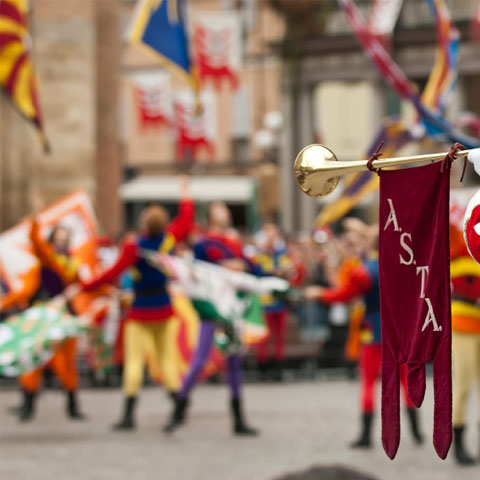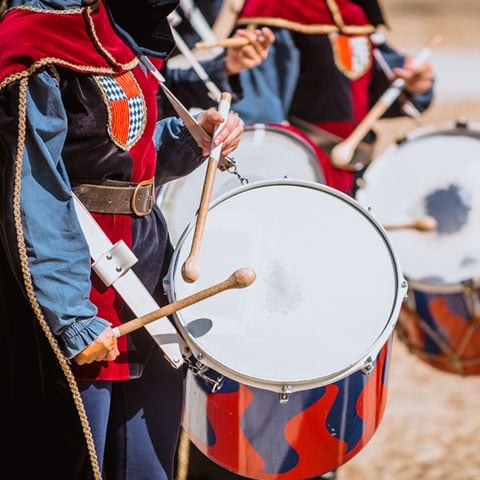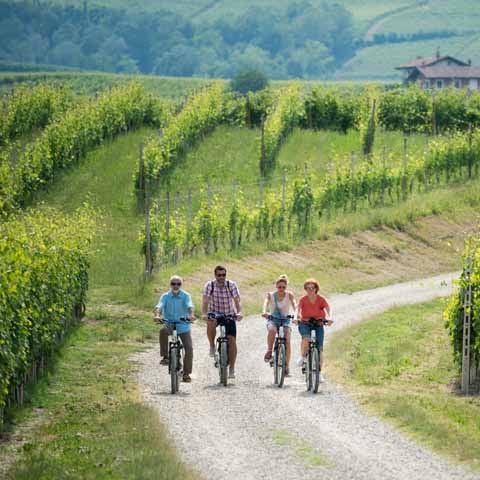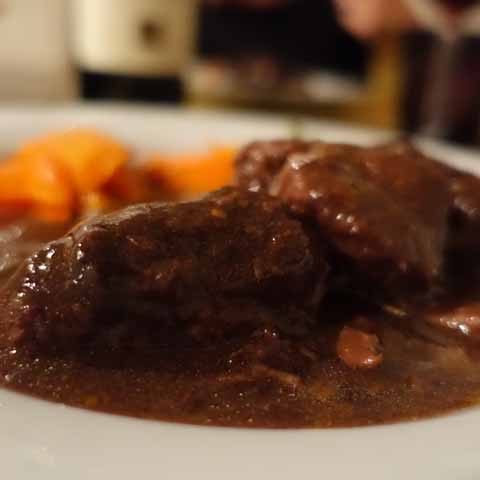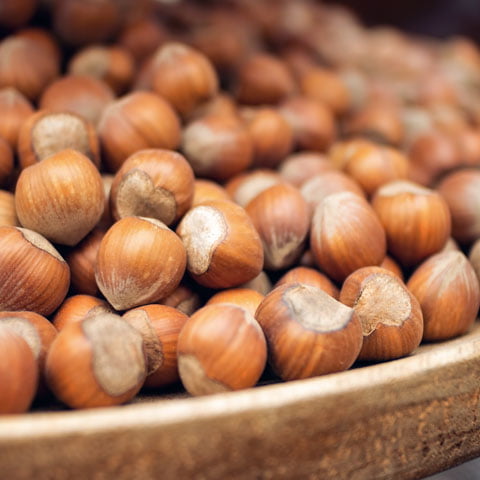Though the area of Asti is most well-known for its wines, there are a variety of historical, cultural, and nature-focused activities that travelers can enjoy while vacationing in the city. From historic towers and characteristic buildings to important monuments and sightseeing locales, Asti has something for everyone.
FESTIVALS & EVENTS
To experience the best of Asti’s local festivals, travelers must visit during September. Known as Settembre Astigiano, the month of September features a variety of celebratory events and festivals for both locals and visitors to enjoy.
It begins with the Douja d’Or, a national wine competition for DOC and DOCG wines from across the country. Over 700 Italian wines are showcased and the event features tastings, food pairings created by top-of-the-line chefs, and so much more. Excellent food and prize-winning wine collide in this event – a foodie’s dream.
Following the Douja d’Or is the Festival delle Sagre, or the Festival of Festivals, during which the local traditions and customs are celebrated through exhibitions, costumes, and food. The goal of the festival is to truly represent Asti’s country life. A weekend-long event, the Festival of Festivals attracts hundreds of thousands of visitors. A must-see part of the event is the traditional Sunday parade, which features historic costumes and characters winding through the city’s streets.
The final event of Settembre Astigiano is a classic medieval horse race called the Palio di Asti, which dates back to 1275. Thousands of locals dress up like their ancestors in traditional medieval clothing to cheer on the 21 competitors who ride bareback on horses in Piazza Alfieri. The track is just over 1,475 feet long and the race itself is divided into three heats. In addition to the horse race, there is a celebration that features ample food and wine.
In May, the Fiera Carolingia is held. One of the region’s largest fairs, the event closes off city streets to accommodate 600 stalls at which people sell local products. The fair ends with a firework display and a feast.
In July, the Festival Astimusica, or Asti Music Festival, takes place in the Cathedral Square. A wide range of genres are represented during this festival that is a must-see for those traveling to Asti in the summertime.
In November, travelers can attend the Regional Truffle Fair. The event takes place in Asti’s historic city center and features truffle-focused events such as tastings and conferences as well as an extensive truffle market.
OUTDOOR ACTIVITIES
Asti’s location in the Monferrato hills at the base of the Alps makes it a beautiful destination for those seeking natural views and experiences. Just outside of the city are a variety of gorgeous nature reserves just waiting to be explored. Some of the best natural locales to visit include the Special Natural Reserve of the Andona, Botto, and Grande Valleys (renowned for its paleontological remains), the WWF Oasis of Forteto della Luja, Rocchetta Tanaro Natural Park, and Riserva Naturale della Valle Sarmassa. The last of the four parks may be of particular interest to active travelers as it offers horseback riding and mountain bike trails.
Travelers can also explore the Asti countryside for stunning natural views and a relaxing time in nature.
INDOOR ACTIVITIES
Asti features a variety of historic churches with interiors that are as interesting and stunning as their exteriors.
The Cathedral of Santa Maria Assunta is one of the region’s largest and most beautiful. It was constructed in a characteristic Romanesque-Gothic style in the fifth or sixth century. Contained within the cathedral are tremendous works of art – eighteenth-century frescoes, altarpieces, silver works of art, mosaics, and paintings.
The Collegiata di San Secondo is another church that contains interesting artifacts and works of art. Dedicated to San Secondo, one of the city’s patron Saints, it houses a sixth-century crypt, fifteenth-century frescoes, and a collection of the oldest flags in Asti.
Santa Maria di Viatosto is a church that dates back to the fourteenth century. The Romanesque church is renowned for its thirteenth to sixteenth century frescoes, a wooden Madonna, and a fifteenth century sandstone sculpture. This church also offers stunning panoramic views of Asti and the surrounding areas.
Other notable churches to see include Santa Maria Nuova, Santa Caterina – a spectacular Baroque church, Sant’Anastasio – home to a museum with wonderful antiques and sculptures, the Baptistery of San Pietro, and San Pietro in Consavia – which features the Archaeological Museum, excellent examples of medieval architecture, and works of art.
For even more fascinating art, visit Palazzo Mazzetti, home to the city art gallery. Among the artists with their work on display here are Maestro di San Martino Alfieri, Guglielmo Caccia, various seventeenth century Genoese painters, and nineteenth and twentieth century Piedmontese painters. The ground floor of the building is reserved for temporary exhibitions.
Another must-see for art lovers is Palazzo del Collegio, which is home to an archeological site and an art museum called Museo Civico Sant’Anastasio. The museum features the remains of twelfth century to fifteenth century churches as well as medieval sculptures, while the archeological site is home to the remains of four churches that date from the eighth to the seventeenth centuries.
For those interested in science, the Museo Paleontologico contains a vast collection of archeological artifacts and fossils, including whale fossils and fossilized shells.
For more archeological finds, head to the Domus Romana, which features the remains of a patrician house. Here, visitors can admire an intricate Roman mosaic and remains of ancient decorations.
To take in a show, visit the Teatro Alfieri, a historic theater built in 1860. Despite having been renovated throughout the years, the theatre still exudes history and culture.
SHOPPING
While in Asti, there are a variety of outlets at which travelers can shop. In addition, neighborhood shops and boutiques offer local goods, from handicrafts to fashion to food products. If looking for designer fashions, visit Via Cavour.
FAMILIES & KIDS
Families with children may enjoy a visit to the Natural Reserve of the Andona, Botto, and Grande Valleys, which is internationally renowned for its fossils. Covering an area of nearly 2,300 acres, the park features the fascinating fossils of marine organisms. The wooded area allows visitors to enjoy hiking, mountain biking, and horseback riding. There are also plenty of peaceful spots throughout the park for a nice picnic lunch.
UNIQUE EXPERIENCES
So much of the city of Asti is deeply rooted in its long history. Travelers can experience this history in the parts of the city that are very much still reflective of medieval times.
Throughout Asti, travelers can see medieval tower houses still standing. Once belonging to noble families, the many towers that dot the city earned Asti the name “The City of 100 Towers.” Some of the city’s most notable towers include the Tower of the Comentini, the Torre de Regibus, the Torre Troyana, and the Torre Rossa. Of these, the Torre Troyana is the tallest tower not only in Asti, but in the entire Piedmont region, and it has also become a symbol of the city.
From narrow streets to ancient buildings to characteristic towers, churches, and remnants of the old town wall, there is a palpable history still alive in Asti today.
For a deep dive into the Piedmont region’s history, cuisine, and culture, be sure to spend time in Asti. This charming city is primarily known for its food and wine, yet its medieval towers, archeological ruins, and stunning churches seem to dazzle all who visit.
Travel Guides
The Piedmont Region of Italy
The Cities of Piedmont, Italy
